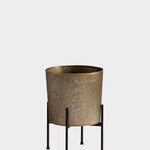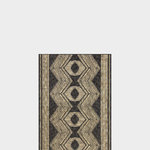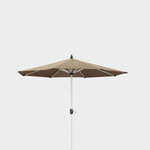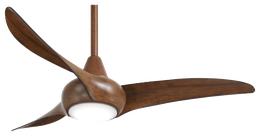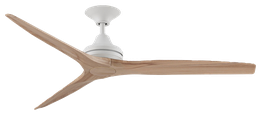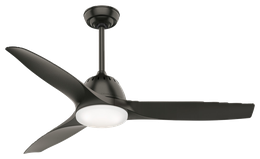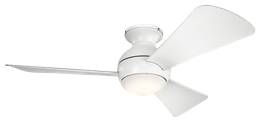FREE shipping on orders over $49!* Details
- All Products
- Hall
- Ceiling Lighting
- Ceiling Fans
Ceiling Fans
Best Seller
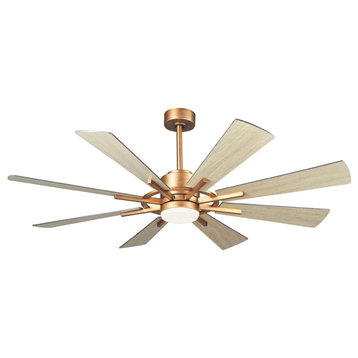
60 in. Indoor/Outdoor Windmill 8-Blade Gold Ceiling Fan with Remote and DC Motorby Whoselamp(5)
$226
Free Shipping
Featuring a striking windmill silhouette with 8 reversible walnut finish blades, this transitional Fan LED ceiling fan will bring a rustic farmhouse look into your space. And the gold finish provides industrial accenting to this modern handsome design, the energy-efficient LED light is integrated with a white glass shade, meet the daily lighting needs. Easily operate this fan with the included remote control, also a convenient reverse blades direction function.
Features:
- Made from metal, wood, and glass, best combination of the modern and industrial style
- 6-speeds DC motor ensures you find the exact setting for your stimulating comfort
- Integrated 15-Watt LED light included, 3000K warm white color
- Handheld remote control for fan speed and light settings
- Comes with 4 in. and 10 in. downrod included
- Included all mounting hardware, easy to install it
- Supports mounted up to a 15° angle
- Limited lifetime warranty and any replacement parts is available
- Motor power: 40-Watt, hight speed power: 35-Watt
Details:
- Overall Length*Width*Height:60"*60"*13.07"
- Product Weight:8.6KG
- Product Material: copper+iron+aluminum+plywood+glass
- Mounting Type: hanging pipe
- Rod Length: 4 inches/10 inches
- Body Color: Gold
- Number of Blades: 8
- Reversible: Yes
- Blade Material: Plywood
- Blade Color:HT-1055-3PU/MS5036
- Blade Size:3.5*6.2*22.6"
- Number of Lights: 1
- Bulb included: yes
- Bulb Type: LED
- Color Temperature: 3000
- Light Max Power: 15W
- Motor Type:DC
- Motor Power: 40W
- Motor Max Speed: 100RPM
- Control Type: DC
- Fan Speed: 6
- CFM: 6500
- Hight Speed Power: 35W
Best Seller
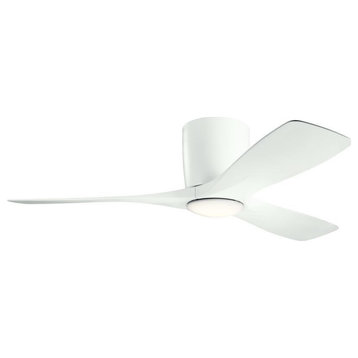
3-Blade Hugger Ceiling Fan Walnut Blades Frosted White Polycarbonate LED Lightsby Bailey Street Home(44)
$192
Free Shipping
3-Blade Hugger Ceiling Fan with Walnut Blades with Frosted White Polycarbonate LED Lights 48 inches W x 10.25 inches H-Matte White Finish . The beautifully designed Upland Buildings hugger-style ceiling fan offers sculpted blades integrated LED light Matte White finish and a full function wall control system for optimal comfort.
- Bulb Shape: Integrated
- Dimable: Yes
- Design: 3 Blade Propellar
Best Seller
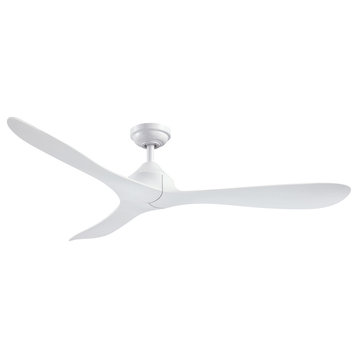
56 in Remote control Modern Ceiling Fan with 3 Blades, Whiteby Whoselamp(6)
SALE
$161$183
Free Shipping
Designer Style: Modern 3 blades metal finish, 4.5 in down rod, suits for most room.
Motor & Fan: With the modern black or white finish, the fan provides 6 fan speeds and delivers powerful air movement with quite a performance
Remote Control: You can keep the fan works with the remote
Warranty: 1-year unlimited warranty, friendly customer service, 100% SATISFACTION GUARANTEED
Motor & Fan: With the modern black or white finish, the fan provides 6 fan speeds and delivers powerful air movement with quite a performance
Remote Control: You can keep the fan works with the remote
Warranty: 1-year unlimited warranty, friendly customer service, 100% SATISFACTION GUARANTEED
- Number of blades: 3
- Number of speed settings: 6
- Remote control included: Yes
- Battery operated: Yes
- Batteries included: No
- Motor type: DC
- Mounting: Down rod mounted
- Number of rods included: 1
- Rod lengths: 4.5 in
- Overall Size: D: 56 in*H:10.6in
- Canopy Size: D 5.8 in
- Weight: 17.52 lbs
- Maximum airflow speed: 4611 CFM
- Reverse airflow: Yes
- Wall switch operated: No
- Slanted ceiling compatible: Yes
- Maximum angle: 15 degree
- UL listed: Yes
- UL rating: Dry
- Wipe clean with a damp cloth
- Note: Item must be hardwired and professional installation is recommended
Best Seller
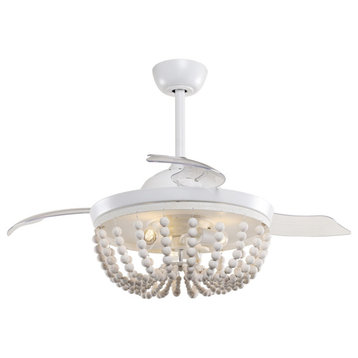
42 in Modern White Ceiling fan with Retractable Bladesby FLINT GARDEN INC(9)
$156
Free Shipping
Ceiling Fan with Lights: 3*E26 bulbs (not included) to provide ample illumination and trim your electric bill.
Ceiling fan with remote: With the remote control, the fan provides 3 fan speeds (Low, Medium, High) and delivers powerful air movement with quite a performance.
Ceiling fan with downrod-Mount: Adjustable hanging height, 4 &10 inch downrod included, you can choose the length according to your needs.
Modern Ceiling Fan: It is a better combination of a ceiling fan and light.
Warranty:1-year unlimited warranty, friendly customer service, 100% SATISFACTION GUARANTEED
Ceiling fan with remote: With the remote control, the fan provides 3 fan speeds (Low, Medium, High) and delivers powerful air movement with quite a performance.
Ceiling fan with downrod-Mount: Adjustable hanging height, 4 &10 inch downrod included, you can choose the length according to your needs.
Modern Ceiling Fan: It is a better combination of a ceiling fan and light.
Warranty:1-year unlimited warranty, friendly customer service, 100% SATISFACTION GUARANTEED
Features:
- Fixture Finish: White
- Design: Standard
- Mounting: Downrod-Mount
- Downrod Length: 4 inches and 10 inches(2 pcs)
- Style: Modern & Contemporary
- Indoor/Outdoor: Indoor
- Number of Lights: 3
- Bulb Base: E26
- Bulb Included: No
- Number of Blades: 3
- Blade Span: 42 inches
- UL Rating: Dry
- Slanted ceiling compatible: Yes
- Maximum angle: 15°
- Overall Size: D: 42 ”*H:18.62”
- Canopy Size: D 5.9”
- Weight: 22 lbs
- Rated Voltage: 110-120 V
- Motor: 153x12mm pure copper motor
- Features: Remote Control
- Remote Included: Yes
- Suggested Room Size: 90-225 sq.ft
Best Seller
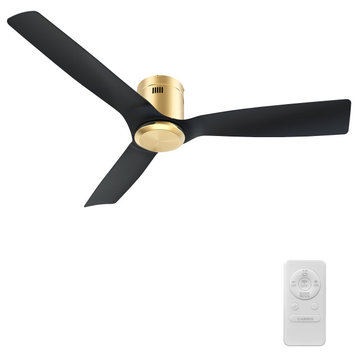
CARRO 52" 3 Blades Flush Mount Ceiling Fan with Remote Control No Light, Black/Goldby CARRO(4)
SALE
$126
Free Shipping
This 52''electric fan keeps your space cooland stylish. It is a soft modern masterpiece perfect for your indoor living spaces. This ceiling fan is a simplicity designing with Gold finish, use very strong ABS blades. The fan features remote control.
Note:Not being required a wall switch.
Note:Not being required a wall switch.
Features
- HIGH-QUALITY MATERIALS: Made with durable and ultra-durable materials.
- POWERFUL DC MOTOR: 10-speed DC motor delivers a strong airflow with energy efficiency. The adjustable settings including reversible airflow options and adjustable speeds.
- REVERSIBLE MOTOR: Downdraft summer mode and updraft winter mode.
- REMOTE CONTROL: Use the multifunctional remote control to control your fan’s settings.
- EASY INSTALLATION: Hassle-free installation with a step-by-step instructions.
- INDOOR USE: Tested for safety. Indoor use only. ETL certified.
- MOUNTING: Secure to flush mount directly on ceiling.
- NOTE: NOT compatible with sloped surfaces.
Specification
- Fan Overall Dimensions: 8.9" H x 52" W x 52" D (No downrod option, Flush mount)
- Product Width: 52”
- Weight:13.5 lb
- Speed Options:10
- Control:Remote Control Only
- Dimmable:No
- Full function remote control - fan speed, light on/off, reverse function
- Material of blades:ABS
- Input power:120 VDC,60 Hz
- Number of Blades:3
- Airflow:5070CFM
- Energy Guide: (All estimate based on typical use, excluding lights).
- Energy Use: 14 Watts.
- Estimated Yearly Energy Cost: $4 (Based on 12 cents per kWh and 6.4 hours use per day. Your cost depends on rate and use.)
Airflow:
- Average 3597 Cubic Feet Per Minute.
- Efficiency: 250 cubic Feet Per Minute Per Watt.
- All estimates are based on typical use, excluding lights.
- Package List
- 10-speed reversible DC motor
- 3 ABS Fan Blades(Acrylonitrile Butadiene Styrene, ultra durable & heat resistant).
- Multifunctional remote control - fan speed, reverse function, and scheduling
- Flush mount, no downrod option
- No light source or LED light kit
- Easy installation with step-by-step instructions
Best Seller
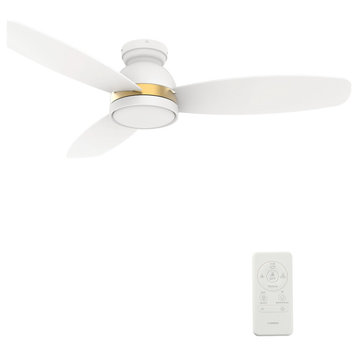
CARRO 48" Flush Mount Ceiling Fan With Dimmable LED Light and Remote Controlby CARRO(6)
SALE
$148$199
Free Shipping
Modern ceiling fan can easily handle a variety of decoration styles, making your home less monotonous and more unique to you.
5 Way to Control: This ceiling fan with remote control can also be controlled by voice, compatible with Alexa, Siri Shortcut, Google Home. For example, "Alexa, adjust the ceiling fan to 5, the yellow light to 70%. 5 ways to control, enjoy the low profile ceiling fan. Use the app to achieve remote control of the ceiling fan no matter where you are. More smart ceiling fan features are available in the APP.
3 Light Colors and Dimmable LED Light: Lights and fans can be controlled separately. This ceiling fan with light has 1915 lumens, 22 watts, dimmable 1% to 100% and 3 color temperature (2700K warm light, 3500K full light, 4000K cool light). According to different scene, use the remote control to adjust the brightness and color temperature of the light that you think are suitable. This ceiling fan with LED light can give you a perfect lighting atmosphere.
Timer Function and Schedule Function: You can make the flush mount ceiling fan turn off automatically after 1/2/3/4/5/6/7/8 hours. In addition, you can also use the schedule function to make your ceiling fan work according to the set time and status. For example, the living room ceiling fan can be set to: Fan: on. yellow light: on. white light: off. time: 17:00. repeat: Everyday. " You can control multiple ceiling fans at once, or set multiple schedules for a single fan.
Reversible DC motor: This modern ceiling fan is equipped with a powerful DC motor that provides ultra-quiet airflow up to 3300CFM. The latest brushless silicon steel DC motor provides extremely quiet performance and has 10 speeds to meet your needs. And the ceiling fan's reverse airflow function allows you to switch the direction from downward to upward, Keeping cool in summer and warm in winter.
5 Way to Control: This ceiling fan with remote control can also be controlled by voice, compatible with Alexa, Siri Shortcut, Google Home. For example, "Alexa, adjust the ceiling fan to 5, the yellow light to 70%. 5 ways to control, enjoy the low profile ceiling fan. Use the app to achieve remote control of the ceiling fan no matter where you are. More smart ceiling fan features are available in the APP.
3 Light Colors and Dimmable LED Light: Lights and fans can be controlled separately. This ceiling fan with light has 1915 lumens, 22 watts, dimmable 1% to 100% and 3 color temperature (2700K warm light, 3500K full light, 4000K cool light). According to different scene, use the remote control to adjust the brightness and color temperature of the light that you think are suitable. This ceiling fan with LED light can give you a perfect lighting atmosphere.
Timer Function and Schedule Function: You can make the flush mount ceiling fan turn off automatically after 1/2/3/4/5/6/7/8 hours. In addition, you can also use the schedule function to make your ceiling fan work according to the set time and status. For example, the living room ceiling fan can be set to: Fan: on. yellow light: on. white light: off. time: 17:00. repeat: Everyday. " You can control multiple ceiling fans at once, or set multiple schedules for a single fan.
Reversible DC motor: This modern ceiling fan is equipped with a powerful DC motor that provides ultra-quiet airflow up to 3300CFM. The latest brushless silicon steel DC motor provides extremely quiet performance and has 10 speeds to meet your needs. And the ceiling fan's reverse airflow function allows you to switch the direction from downward to upward, Keeping cool in summer and warm in winter.
- 3 Color Temperature: 2700K, 3500K, 4000K
- Dimmable LED Light: 1-100%
- Timer: 1-8 hours
- Schedule Function: Yes
- Recommended Room SizeSmall Room (75-144SQ FT)
- 5 way to control: remote control / APP / Alexa / Google Home / Siri Shortcuts
- Recommended Uses For Product:Air Circulation
Package List:
- 10-speed reversible DC Motor
- 3 Plywood Fan blades
- Remote Control
- Flush mount, No downrod option
- Includes integrated LED light kit
Best Seller
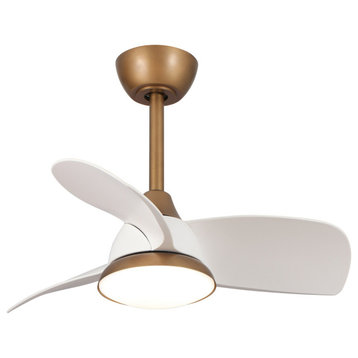
28 in. Modern Integrated LED Indoor Ceiling Fan with Remote Control and DC Motorby Whoselamp(5)
$107
Free Shipping
This 28 in. antique brass gold finish ceiling fan features with a 6 speed motor, high-performance assures powerful, whisper-quiet operation. Flawlessly implemented the industrial charming, the integrated LED lampshade shallow dome in 18-Watt, light in 3000K, 4000K, 6000K dimmable. 3 spinning blade element availabled in 2 finishes (Black/White), easily controlled by remote, surely a statement piece for your kitchen, dining room, living room, bedroom or foyer.
Features:
- Color Changing Technology,DC Motor,Dimmable,Easy Install,Reversible Motor,Timer
- 6-speed whisperwind DC motor delivers ultra-powerful air movement with whisper-quiet performance so you get the cooling power you want without the noise
- Reversible motor allows you to change the direction of your fan from downdraft mode during the Summer which helps cool the room to updraft mode during the Winter to help circulate trapped warm air near the ceiling
- Handheld remote included for easy fan adjustments from anywhere in the room
- Included light kit lets you control the lighting and ambiance of your living space, the long-lasting LED bulbs have longer lifespan than traditional bulbs
- Fully-dimmable integrated LED light comes included, also support CCT in 3000/4000/6000K 3-light temperatures
- UL rated safty for indoor use only, making it ideal for spaces like living rooms, bedrooms, home offices, and kitchens
- 10 in. downrod assembly included, support sloped ceiling but max 15 degrees
- Motor type in DC, powered in 27-Watt, light maximum power in 18-Watt
- Limited lifetime warranty, any replacement resend free
- Overall Length*Width*Height:28"*28"*10 1/2"
- Product Weight:3.5KG
- Product Material:Iron, ABS
- Mounting Type: Downrod Mounted
- Rod Length:10”
- Body Color: Gold
- Number of Blades:3
- Reversible:Yes
- Blade Material:ABS
- Blade Color:Black
- Blade Size:16.3" * 7"
- Socket Type:LED
- Number of Lights:No
- Bulb included: Yes
- Color Temperature:3000/4000/6000K,dimmable
- Light Max Power:18
- Motor Type:DC
- Motor Power:27
- Motor Max Speed:304
- Control Type:M28C0327Z18
- Fan Speed:6
- CFM:4980
- Hight Speed Power:27
- Energy Efficiency:184.44
Best Seller
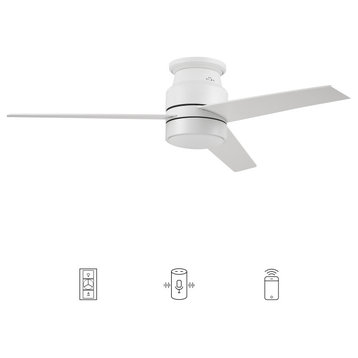
Carro 52'' Indoor Ceiling Fan with Light Wall Control and Remote by Wifi App, Whiteby Carro(70)
$165
Free Shipping
- [MODERN SMART CEILING FAN]: RANGER Smart Ceiling Fan comes with an LED light kit cased with white glass and black fan blades.
- The contemporary and sleek design will bring a modern touch to home décor. One of the most affordable smart fans in the market.
- Measures 52 x 52 x 12.07 inch.
- [MULTI-SPEED REVERSIBLE FAN MOTOR]: Reversible Whisper-Wind AC motor delivers ultra-powerful airflow with quiet performance.
- Reversible fan direction: change the direction from downdraft mode during the summer and updraft mode during the winter.
- [BRIGHT LED LIGHT KIT]: Super-bright and energy-efficient LED Light with bright and warm settings: create ambiance and control lighting intensity.
- The long-lasting LED bulbs have a much longer lifespan than traditional bulbs.
- [SMART HOME AUTOMATION]: Adjust fan speed and turn on/off your lights from anywhere with a smartphone.
- CarroHome Ceiling Fan Smart Switch works with Amazon Alexa, Google Assistant, Siri, and more when you connect with our CarroHome FREE App.
- CarroHome Smart Ceiling Fan Switch offers hands-free simple voice command to control lights and fans.
- Create schedules and easily set timer to automatically turn light and fan on/off with the preset times to ward off potential intruders.
- [INSTALLATION NOTE]: Only with smart wall control(with Wifi function), it has to connect with Live, Neutral, and Ground wire.
- Please confirm the house have the above wire for installation.
NOTE:
REQUIRES NEUTRAL WIRE(white), LIVE WIRE (red or black), BARE or GROUND WIRE(green) and LOAD WIRE(separate two wires, one for light, the other one for fan). Please confirm that the wiring in your home is compatible before purchasing the smart ceiling fan (older house may not have neutral wires). No Hub required. No canopy module required.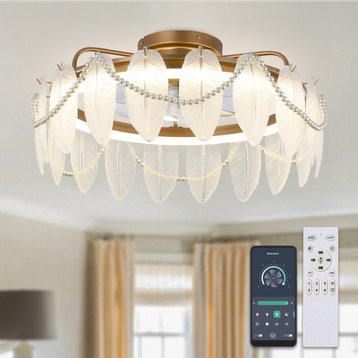
20" French Country Ceiling Fan with Remote Control and Dimmable Light, Goldby Bella Depot
$160
Free Shipping
Embracing a French Romantic Style, this ceiling fan exudes a timeless charm that adds a touch of romance to your space. Experience the beauty and convenience of our gold-colored ceiling fan, featuring a pearl surround lamp body, transparent crystal feathers, reversible airflow, multiple speeds, dimmable lighting, and easy remote or app control. Elevate your space with the allure of our French Romantic Style ceiling fan.
The fan features a luxurious gold color, adding a touch of glamour and sophistication to your space. The pearl surround lamp body serves as a stunning centerpiece, exuding elegance and charm. Surrounding the lamp body, transparent crystal feathers create a mesmerizing circle, casting a beautiful play of light and adding a touch of enchantment to the fan's design.
Versatility is a key aspect of this fan, as it can be reversed to provide both upward and downward airflow. This feature allows you to customize the airflow direction according to your needs and preferences.
With 6 wind speeds and dimmable functionality, you have complete control over the fan's performance. Adjust the speed to achieve the perfect level of cooling and dim the lights to create the desired ambiance.
Controlling the fan is effortless with the included remote control or the option to use a dedicated mobile app. Whether you're relaxing on the couch or busy with a task, you can conveniently adjust the fan's settings without leaving your seat.
The fan features a luxurious gold color, adding a touch of glamour and sophistication to your space. The pearl surround lamp body serves as a stunning centerpiece, exuding elegance and charm. Surrounding the lamp body, transparent crystal feathers create a mesmerizing circle, casting a beautiful play of light and adding a touch of enchantment to the fan's design.
Versatility is a key aspect of this fan, as it can be reversed to provide both upward and downward airflow. This feature allows you to customize the airflow direction according to your needs and preferences.
With 6 wind speeds and dimmable functionality, you have complete control over the fan's performance. Adjust the speed to achieve the perfect level of cooling and dim the lights to create the desired ambiance.
Controlling the fan is effortless with the included remote control or the option to use a dedicated mobile app. Whether you're relaxing on the couch or busy with a task, you can conveniently adjust the fan's settings without leaving your seat.
Details
- Brand: Bella Depot
- Style: Contemporary
- Color: Gold
- Size:19.6 inch
- Motor: DC Motor
- Material: Metal, Crystal, pearl
- Voltage: 110 -120 Volts
- Color temperature: Gradually Dimmable (3 light cycles)
- Dimmer Switch: NO
- Light source type: LED
- Light Kit Included
- Dimmable Light : Yes
- Control: Remote Control Included, APP control
- The battery for the remote control is AAA
- Light Wattage: 18W
- Motor Wattage: 15W
- Number of Blades: 7 Reversible Blades
- Speed: 6
- Reversible: Yes
- Location: Indoor Only
- Room Size: Small rooms (up to 12 X 14)
- UL Listed for core parts
- ETL Listed for ceiling fan
- Hardwired, Assembly Required
- WARRANTY: Lifetime warranty on motor; One-year warranty on all other parts
Best Seller
56 in Remote control Modern Ceiling Fan with 3 Blades, Blackby Whoselamp(6)
SALE
$167$197
Free Shipping
Designer Style: Modern 3 blades metal finish, 4.5 in down rod, suits for most room.
Motor & Fan: With the modern black or white finish, the fan provides 6 fan speeds and delivers powerful air movement with quite a performance
Remote Control: You can keep the fan works with the remote
Warranty: 1-year unlimited warranty, friendly customer service, 100% SATISFACTION GUARANTEED
Motor & Fan: With the modern black or white finish, the fan provides 6 fan speeds and delivers powerful air movement with quite a performance
Remote Control: You can keep the fan works with the remote
Warranty: 1-year unlimited warranty, friendly customer service, 100% SATISFACTION GUARANTEED
- Number of blades: 3
- Number of speed settings: 6
- Remote control included: Yes
- Battery operated: Yes
- Batteries included: No
- Motor type: DC
- Mounting: Down rod mounted
- Number of rods included: 1
- Rod lengths: 4.5 in
- Overall Size: D: 56 in*H:10.6in
- Canopy Size: D 5.8 in
- Weight: 17.52 lbs
- Maximum airflow speed: 4611 CFM
- Reverse airflow: Yes
- Wall switch operated: No
- Slanted ceiling compatible: Yes
- Maximum angle: 15 degree
- UL listed: Yes
- UL rating: Dry
- Wipe clean with a damp cloth
- Note: Item must be hardwired and professional installation is recommended
Best Seller
3-Blade Ceiling Fan Weathered Wood Blades and Rope Accents LED Light Kit 60by Bailey Street Home(4)
$503
Free Shipping
3-Blade Ceiling Fan with Weathered Wood Blades and Rope Accents with LED Light Kit 60 inches W x 17.5 inches H-Matte White Finish . Modern meets maritime in the sleek The Budding. Designed with a nautical flair in mind The Budding is available in Matte White with Weathered Wood blades and Metallic Matte Bronze with Walnut blades and features composite blades. The Budding is so versatile; it can be used for both indoor and outdoor spaces.
- Amps: 0.36
- Color Temperature: 3000
- Lumens: 1500
- CRI: 90
- Canopy Included: Yes
- Shade Included: Yes
- Sloped Ceiling Adaptable: Yes
- Canopy Diameter: 6.00
- Rod Length(s): 4.50
- Dimable: Yes
- Assembly Required: Yes
- Canopy Included: Yes
- Sloped Ceiling Adaptable: Yes
- Dimable: Yes
- Shade Included: Yes
Best Seller
20" Crystal Caged Chandelier Ceiling Fans with Light Kit and Remote Control, Satin Nickelby Breezary(7)
$168
Free Shipping
Our morden ceiling fan is a combination of ceiling fan and chandelier in a unique style, which features impeccable style and a clean, crisp look. The crystal kit surrounds an energy-efficient Reversible AC fan motor capable of meeting indoor quality air requirements with ease. Inside the crystal kit, it hosts six non-dimmable bulbs to offer a bright illumination. Reversible motor allows you to change the direction of your fan from downdraft mode during the summer which helps cool the room to updraft mode during the winter to help circulate trapped warm air near the ceiling.
Features:
- Style: Contemporary Formal/Glam/Vintage
- Materials: Metal, Crystal
- Color: Satin Nickel
- Number of Blades: 5
- Blade Pitch: 12.5 degree
- Material of Blades:ABS
- Blade color: Sliver
- Bulbs: E12 * 6 (not included)
- Max Buble Wattage:25W
- Angled Ceilings: up to 16 degree
- Motor Type: AC Induction
- Reversible Motor: Yes
- Motor voltage: 110V-120V 60Hz
- Max Motor Speeds: 950
- Max CFM: 1095
Dimensions:
- Installer's Choice three-position mounting system allows for standard, low or angled mounting
- Downrod (short): 4 inches long
- Downrod (long): 10 inches long
- Blade Size:5.27 inches(L)*5.27inches(W)
- Overall Size: 21.6 inches diameter x 21.6 inches height
- Net Weight: 25 lb
Disclaimers & Disclosures:
- Assembly Required
- Unless otherwise noted, this fixture needs to be hardwired. Professional installation is recommended.
Best Seller
24 in. Indoor Bronze Gold Farmhouse Rattan Caged Ceiling Fan with Remote Kitby Whoselamp(6)
$314
Free Shipping
Look no further for a ceiling fan with lights and style than this 24.2 in. indoor cage fan ideal for a variety of style settings. Light sources glow from within a cottage bronze gold farmhouse rattan shade for an illumination sure to warm any living space. Blades rotate within the cage design to offer a cool downdraft in the summer or a warm updraft in the winter for year-round comfort.
- Operate fan speed and lights can be separately controlled by remote
- Quiet 6-speed reversible DC motor for maximum year-round comfort and savings, strong wind while no noise
- Lamp body is made of iron and decorated with rattan shade, gorgeous and farmhouse style ceiling light fixture
- Support sloped ceiling but maximum slope is 15°
- All mounting hardware and installing guide come included
- Limited lifetime warranty, and replacement resend free
- Fan requires LED 4-Watt x 6, E12 base socket Type B, bulbs not included
- Package includes with 8 in. down rod for mounted
- 6-speeds controller, allowing you to choose the 1 best suit for your comfort
Details:
- Assembled Size (in.): 24.2" * 24.2" * 18.1"
- Downrod Length (in.): 8
- Fan Blade Length (In.): 7" *3.8" - 16.5" Span
- Airflow (CFM): 1735
- Blade Color: Bronze Gold
- Bulb wattage (watts): 24
- Damp/Wet Rating: Dry Rated
- Fan Blade Material: Acrylonitrile Butadiene Styrene (ABS)
- Fixture Color/Finish: Bronze Gold
- Light Bulb Base Code: E12
- Motor Speed (RPM): 720 RPM
- Mounting Type: Downrod Mount
- Number of Blades: 3 Blades
- Number of Lights: 6 Light
- Number of Speeds: 6
- Product Weight (lb.): 20 lb
- Recommended Light Bulb Shape Code: E12
- Recommended Room Size: Small Room
Honeywell Carmel Ceiling Fan With Light and Remote, 48", Bronzeby Honeywell Ceiling Fans(3729)
$156
A traditional ceiling fan with a modern twist, the Honeywell Carmel has the perfect balance of style, function, and illumination. This remote control ceiling fan features reversible blades, LED lighting, two mounting options, and a reversible motor for year-round comfort.
- MODERN / CONTEMPORARY: Boasting a sleek, bronze finish - the Honeywell Carmel ceiling fan elevates your indoor spaces and and adds comfort and light just where you need it.
- LARGE TO MEDIUM SPACES: Having a blade span of 48 inches, this fan is perfect for medium to large rooms such as living rooms, bedrooms, dens and much more!
- CEILING FAN WITH LIGHT: This modern ceiling fan houses two E26 / A15 light bulbs (included) and provides 800 lumens, 8.5 watts, a 3000K color temperature, and dimmable 20% to 100%
- REMOTE CONTROL: Adjust the power, 3 speed settings, and the light with a simple push of a button with this remote control ceiling fan (wall mount and batteries included).
- DUAL MOUNT COMPATIBLE: This fan can be hung by the standard downrod mount, 4 inch downrod included, or on angled ceilings (angle bracket for angles greater than 17 degrees sold separately)
- DUAL-FINISH REVERSIBLE BLADES: This ceiling fan comes with a different finish on each side of the blades. One side comes in a cimmeron finish, while the other side showcases an ironwood finish. Pick the look that best fits your space!
- LIMITED LIFETIME WARRANTY: A Limited Lifetime warranty is offered on this product by the manufacturer.
Best Seller
52" Satin Brass Ceiling Fan w/ Blades, LED Light & Wall Control - Craftmadeby Craftmade(593)
SALE
$236$602
Pour on the breeze with the Craftmade Bordeaux ceiling fan. This eye-catching three blade fan with its LED light source can be installed on a down rod or semi-flush mounted for lower ceilings. Quench your thirst for style with this striking fan.
FEATURES
- Heavy-Duty, 3 Speed Reversible Motor
- Tri-mount System, Standard with both semi-Flush mount and ball hanger mounting systems for flat or angled ceilings
- 6 Downrod (Included)
- Limited Lifetime Warranty
- Custom Clear Acrylic Blades Included
- Integrated LED Light Source (Dimmable)
- Optional Lens Cover Included
- Hard-Wired Dual Wall Control Included - 4 Speed Fan Control and Full Range Dimmer
- SPECS
- Blade Sweep 52
- Number of Blades - 3
- Blade Pitch 16 Degrees
- Motor Size (MM) 172 x 17
- AMPS (Hi Speed) - 1
- Energy Guide Airflow (Cubic Feet Per Minute) 3,942
- Energy Guide Wattage 30
- Energy Guide Efficiency (CFM Per Watt) 133
- Airflow at High Speed (Cubic Feet Per Minute) 5,426
- LED SPECS
- Color Temp 3000K
- Lumens 1,350
- CRI - 90
- LED Module is Guaranteed for 5 Years. Bulb TypeLED Number of Bulbs Integrated Bulbs Included Yes Bulb Wattage 17
Bella Depot Modern Design Flush Mount Ceiling Fan with Remote and LED Lightby Bella Depot
Updated Gradually Dimmable Light: Comes with replaceable LED light and is Gradually Dimmable (Color Temperature Dimmable), it can be gradually dimmed. It will cycle through 3 light tones (Warm White, Neutral White, and Cool White), turn off the light then turn it on again, the light tone will change.
Retractable Blades: 3 acrylic blades can be reversible automatically. Whisper-Quiet Performance making it perfect for any type of room (especially bedrooms)
$128
Free Shipping
Details:
Get stunning style and enjoy a refreshing breeze with this Bella Depot Contemporary Ceiling Fan. With retractable blades and a stylish fan, this Contemporary bladeless ceiling fan is sure to brighten up the decor of your living space. An integrated LED light helps to provide ambient illumination and save on your electricity bill. The 6-speed motor delivers proper air movement as needed. If you are looking for a fan that is on the cutting edge of design and function, this is the fan is where it's at.Updated Gradually Dimmable Light: Comes with replaceable LED light and is Gradually Dimmable (Color Temperature Dimmable), it can be gradually dimmed. It will cycle through 3 light tones (Warm White, Neutral White, and Cool White), turn off the light then turn it on again, the light tone will change.
Retractable Blades: 3 acrylic blades can be reversible automatically. Whisper-Quiet Performance making it perfect for any type of room (especially bedrooms)
- Remote Control: 6 fan speeds and LED flush mount ceiling fan can be controlled with remote control.
- Package Includes: Ceiling Fan with Light, Remote Control, Installation Manual
- If you have any questions, please feel free to contact us via our email, and we will reply in 24hrs.
Details:
- Color: White
- Material: Metal, Plastic
- Voltage: 110 -120 Volts
- Color temperature: Gradually Dimmable (3 light cycles)
- Dimmer Switch: NO
- Light source type: LED
- Light Kit Included
- Control: Remote Control Included
- Remote Batteries included
- Light Wattage: 36 W
- Motor Wattage: Number of Blades: 3
- Speed: 6
- Location: Indoor Only
- Room Size: Small & Medium rooms (up to 12 X 14)
- UL Listed for core parts
- ETL Listed for ceiling fan
- Hardwired, Assembly Required
- WARRANTY: Lifetime warranty on motor; One-year warranty on all other parts
CARRO Smart Voice Control Ceiling Fan with Dimmable LED Light and Remote, Black/Gold, 52" Downrodby CARRO(42)
$210
Free Shipping
This 52" smart ceiling fan keeps your space cool, bright, and stylish. It is a soft modern masterpiece perfect for your large indoor living spaces. This Wifi smart ceiling fan is a simple design with a Black finish, uses elegant Plywood blades, Glass shade, and has an integrated 4000K LED daylight. The fan features Remote control, Wi-Fi apps, Siri Shortcut, and Voice control technology (compatible with Amazon Alexa and Google Home Assistant ) to set fan preferences.
- Airflow: 4500CFM; PLY wood blades(5pcs)
- Compatible with Wi-Fi apps and Voice control via Google Assistant, Amazon Alexa, and Siri Shortcut. Function on the remote control - fan speed, fan on/off, light on/off; Forward/Reverse;
- Fans are made with incredibly efficient and completely silent DC motors.
- 10-speed reversible motor allows you to change the direction of your fan from downdraft mode during the summer to updraft mode during the winter;
- Includes integrated 2150Lumens LED light kit(22W) with 3500K (2700K warm light/4000K daylight), it offers lower energy consumption and a longer life span;
- Standard and angled mounting system,1 extension down-rod included (6 in. )
- Coupling cover and canopy cover conceal exposed hardware Easy installation with step-by-step instructions;
- ETL Certified Product;
- For both Indoor and Outdoor use.
MinkaAire White Mesa 52" 5-Blade Indoor Flush Mount Fanby Minka Aire(355)
SALE
$83$122
Free Shipping
Product Features:
- Finish: White
- Fan Type: Hugger
- Blade Span: 52"
- Number of Blades: 5
- Height: 8.75"
- Speeds: 3
- Location Rating: Dry Location
- Fully covered under Minka-Aire warranty
Minka Aire Light Wave LED Ceiling Fan With Remote Control, Coalby Minka Aire(1160)
$270
Free Shipping
Features
- Model F845-CL
- Coal Finish
- Frosted Glass
- 3 Blades 44" Sweep
- Full Function Remote Control System
- Includes 6" Downrod
- Uses 1-16W LED Bulb (Included)
- 153 x 17mm Motor
- Factory Authorized Seller; Full Factory Lifetime Warranty
Control Specifications
- Model RCS213
- 3-Speed Fan Control
- Full Range Light Dimmer
- Performance
- RPM (High/Low): 193/94
- Airflow: 3673 CFM
- Electricity Used: 60.61 Watts
- Airflow Efficiency: 60.6 CFM/Watts
Best Seller
60 in Modern Ceiling fan with 8 Blades, Remote Control in Matte Blackby FLINT GARDEN INC(9)
$239
Free Shipping
Ceiling Fan with Lights: LED bulbs ( included) to provide ample illumination and trim your electric bill.
Ceiling fan with remote: With the remote control, the fan provides 6 fan speeds and delivers powerful air movement with quite a performance.
Ceiling fan with downrod-Mount: Adjustable hanging height, 6 &10 inch downrod included, you can choose the length according to your needs.
Warranty:1-year unlimited warranty, friendly customer service, 100% SATISFACTION GUARANTEED
Ceiling fan with remote: With the remote control, the fan provides 6 fan speeds and delivers powerful air movement with quite a performance.
Ceiling fan with downrod-Mount: Adjustable hanging height, 6 &10 inch downrod included, you can choose the length according to your needs.
Warranty:1-year unlimited warranty, friendly customer service, 100% SATISFACTION GUARANTEED
Features:
- Fixture Finish: Matte Black
- Design: Standard
- Mounting: Downrod-Mount
- Fan Blade Length:700.5 mm
- Fan Blade Width:97.7 mm
- Total Fan Height:329 mm
- Blade to Ceiling Height:259 mm
- Canopy Height: 140 mm
- Canopy Width:140 mm
- Canopy Depth :54 mm
- Downrod Length: 6 inches and 10 inches(2 pcs)
- Style: Modern & Contemporary
- Indoor/Outdoor: Indoor
- Number of Lights:1
- Bulb Type: LED
- Bulb Watt: 24 W
- Color Temperature(CCT) Kelvin: 3000
- Bulb Included:Yes
- Delivered Lumens (lm): 1466
- Lumensper Watt (lm/W): 61.26
- Color Rendering Index (CRI): 83.4
- Light Cap Included(Yes / No): No
- Number of Blades: 8
- Blade Span:60 inches
- UL Rating: Dry
- Slanted ceiling compatible: Yes
- Maximum angle: 15��
- Overall Size: D: 60 in H:13.1 in
- Canopy Size: D 5.5 in
- Weight: 20.2 lbs
- Airflow: 6200 CFM
- Motor Type: DC
- DC Motor(Yes / No):Yes
- Motor Size(mm):156*12 mm
- Length of wire from Motor(inches):21 mm
- Motor Watts(High):35
- RPM:110
- Features: Remote Control
- Remote Included: Yes
- Suggested Room Size: 90-225 sq.ft
Best Seller
Becky 52" 3-Light Crystal LED Chandelier Fan With Remoteby JONATHAN Y(50)
SALE
$361$799
Our 52" Oiled Bronze fan combines modern glamour and classic style, featuring a mini-chandelier embellished with a crystal drum shade. Five reversible blades create plenty of air flow by remote control. Three LED bulbs provide bright, sparkling light.
Features:
- This fan-light combination adds a touch of glamour to your living room, bedroom or family room
- Remote control provides 3 different fan speeds
- 5 included reversible blades in a Brown finish matched the Oiled Bronze metal
- Fixture can be adjusted to your desired length
- Eco-friendly 9W bulbs included
- Color: Oil Rubbed Bronze with clear shade
- Body Material: Iron
- Includes: One (1) lamp
- Assembly Required
Dimensions:
- Lamp: 28-33 inches high x 52 inches wide x 52 inches deep
Best Seller
52 in Modern Flush Mounted Ceiling fan with 3 Blades in Sand Copperby FLINT GARDEN INC(16)
$171
Free Shipping
Ceiling Fan with Lights: LED bulbs ( included) to provide ample illumination and trim your electric bill.
Ceiling fan with remote: With the remote control, the fan provides 3 fan speeds (Low, Medium, High) and delivers powerful air movement with quite a performance.
Modern Ceiling Fan: It is a better combination of a Ceiling fan and light.
Warranty:1-year unlimited warranty, friendly customer service, 100% SATISFACTION GUARANTEED
Ceiling fan with remote: With the remote control, the fan provides 3 fan speeds (Low, Medium, High) and delivers powerful air movement with quite a performance.
Modern Ceiling Fan: It is a better combination of a Ceiling fan and light.
Warranty:1-year unlimited warranty, friendly customer service, 100% SATISFACTION GUARANTEED
Features:
- Fixture Finish:Sand Copper
- Design: Standard
- Mounting:Flushed Mounted
- Style: Modern & Contemporary
- Indoor/Outdoor: Indoor
- Number of Lights: 1
- Bulb Type: LED
- Bulb Included: Yes
- Bulb Wattage: 18 W
- Blade Span: 52 inches
- UL Rating: Dry
- Overall Size: D: 52 *H:10
- Canopy Size: D 7.7
- Weight: 14.33 lbs
- Airflow: 3800 CFM
- Motor Type: AC
- Rated Voltage: 110-120 V
- Rated power(motor): 50 W
- Dimmable: YES
- Color Temperature: 3000/4000/6000 k
- Lumen: 900 LM
- Wire: #1015 18AWG Black, White, Blue
- Features: Remote Control
- Remote Included: Yes
- Suggested Room Size: 90-225 sq.ft
42" Modern Retractable Ceiling Fan with Light Kit and Remote Control 3 Blades, Gold, 42"by Bella Depot
SALE
$120$176
Free Shipping
Enjoy your new unprecedented comfort life with this multifunctional upgrade ceiling fan from Belladepot. A reversible motor makes it easy to cool your summer and warm your winter, while retractable blades keep you away from dust. With a 36W led light that has warm/cold/neutral light, you will have more freedom to relax. Your lovely house will have a nice modern look with this unique 2in1 ceiling fan.
Highlight:
- Reversible and Retractable: The blades can be reversed to adapt to the changing seasons and are retractable when turn off.
- 36W LED light: The light can be dimmed with three including warm/cold/neutral light.
- 6 Speed: There are six wind speeds from low to high.
- Downrods Included: 5" and 10" down rods are included to suit most rooms. (provide the customized service with maximum 40")
- Fits a sloped ceiling up to 15 degrees.
- Remote control included: The size of the battery (not included) is 12V 23A.
- Timer function: Automatically shuts off at a set time for 1/2/4 hours.
Details:
- Fan Type: Retractable Ceiling Fan
- Mounting: 2 Downrods Included
- Room Size: Small rooms (up to 8 X 10); Medium rooms (up to 12 X 14)
- Body Material: Metal
- Light Kit Included: Yes
- Voltage:120 Volt
- Speed: 6
- Light Color: Warm/Cold/Neutral
- Remote control included: Yes
- Battery Size (not included) : 12V 23A.
- Dry, Damp or Wet Location Listed: Dry
- Sloped Ceiling Compatible: Yes
- Compatible Parts: Light kit;
- Maximum Wattage: 36 Watt
Specifications:
- ETL Listed
- Assembly Installation Required
- Assembly/Install Steps Required
- Behind-the-wall Electric
- Warranty
- Commercial Warranty: Yes
- Product Warranty: Yes
- Warranty Length:1 Year
- Full or Limited Warranty: Limited
Best Seller
72 in. Integrated LED Indoor Natural Brass Ceiling Fan with Light and Remoteby Whoselamp(3)
SALE
$255$289
Free Shipping
Great for large areas or lofts is this 72 in. Natural Brass ceiling fan, The powerful DC motor can cool a large room and push out 7928 CFM of cooling, It features a full-function 6-speed motor that is 3-times the power of a traditional ceiling fan. The included remote control allows you to control the light, speed function, the dome style light kit with plastic lamp shade includes a 18-Watt LED light source and is set at 3000K temperature (warm white). This fan and lighting kit must be hardwired and installed by a qualified electrician.
Features:
- DC Motor,Easy Install,Reversible Motor,Timer
- Included: Downrod Included,Hardware Included,Light Kit Included,Shade(s) Included,Timer
- 6 weather-resistant black aluminum blades, total span 72 in.
- Dome style light kit included, best combination of ceiling fan and chandelier
- High performance reversible DC motor assures powerful, no noisy
- Threaded down rod, 8 in. L x 3/4 in. Dia for tighter stability
- Uses a 18-Watt Integrated LED module, 3000K LED temperature in warm light
- Energy efficient DC motor with 6 speeds, great for large sized room
- Hand-held remote control operates this fan with independent light and speed control
- Reversible function, keeping you warm in winter and cool in summer
- Comes with the English installation instructions, easy to install
- Limited lifetime warranty, any replacements resend free
Details:
- Airflow (CFM): 7928
- Blade Color: Black
- Ceiling Fan Size: Extra Large
- Ceiling Fan Type: Basic
- Color Family: Brass
- Color Temperature: Warm White
- Compatible Bulb Type: Integrated LED
- Control Type: Remote Included
- Damp/Wet Rating: Dry Rated
- Fan Blade Material: Aluminum
- Fixture Color/Finish: Natural Brass
- Light Bulb Type Included: Integrated LED
- Light Type: Integrated
- Motor Speed (RPM): 300 RPM
- Mounting Type: Downrod Mount
- Number of Blades: 6 Blades
- Number of Lights: 1 Light
- Number of Speeds: 6
- Product Weight (lb.): 26 lb
- Watt Equivalence: 36
Dimensions
- Assembled Depth (in.): 72 in
- Assembled Height (in.): 17.82 in
- Assembled Width (in.): 72 in
- Downrod Length (in.): 8
- Fan Blade Length (In.): 36
- Fan Blade Span (in.): 72
- Fan Blade Width (In.): 5
Best Seller
Curtiss 52" Ceiling Fan Satin Brassby Vaxcel(49)
$379
The hand carved solid wood blades and clean lines of the motor housing give the Curtiss ceiling fan its on trend mid-century modern look. This fan is compatible with sloped ceilings and includes a 6 inch down rod (longer down rods sold separately). Exterior damp rated, ideal for indoor or outdoor spaces such as entryways, family rooms, or covered outdoor porches. Remote control included for added convenience. An LED light kit (included) provides energy savings, low maintenance and long-lasting performance.
FEATURES:
- 3-speed settings make it easy to maintain the ideal comfort level
- Dome shaped white frosted glass light kit with dimmable led bulbs included for energy efficiency and savings
- Integrated led light kit produces 1050 lumens when set to its highest level; that's equivalent to approximately a 75 watt incandescent bulb
- Sized to fit rooms up to 350 sq. ft with a 52-in. diameter and 3 propeller blades
- Reduce energy usage year round with the reverse air flow switch, cool air is pushed down or warm air is distributed evenly
- Can be installed using the provided down rod for low or standard ceiling heights and also on a longer down rod (up to 72 inches) for higher ceilings; longer down rods sold separately
- Can accommodate angled sloped ceilings up to 23 degrees
- Hard carved solid wood blades finished in walnut perfectly compliment the satin brass motor housing
- Exterior damp rated, ideal for indoor or outdoor spaces such as entryways, family rooms, or covered outdoor porches
Casablanca 59285 52``Ceiling Fan Wisp Noble Bronzeby Casablanca Fan Company(677)
SALE
$220$400
Free Shipping
A contemporary design with a little flare of retro, the Wisp LED ceiling fan brings a balance of finesse and joviality into your home. The unique curvature in the blades adds a touch of personality to an otherwise clean, elegant design. The Wisp features an integrated light kit with a dimmable, energy-efficient LED bulb that shines a soft light through cased white glass. The result is a composition with an elegant, airy aura that will inspire joy and comfort throughout the entire room.
- 52``Ceiling Fan
- Collection: Wisp
- Finish: Noble Bronze
- Width: 52.00``
- Height: 13.96``
- Safery Rating: Indoor
- Safety Listing: ETL
- Bulbs: 1 X Module 18.00W 1520.00lm, Included
Hunter 5930 Aker 36" 3 Blade Indoor Ceiling Fan - Blades and LED - Whiteby Hunter Fan Company(3065)
SALE
$100$150
Free Shipping
Features Scandinavian style with mid-century color palette Ideal for use in small spaces Includes: White finish includes reversible Fresh White or Natural Wood blades Black finish includes reversible Matte Black or American Walnut blades Brushed Nickel finish includes reversible American Walnut or Natural Wood blades Motor constructed from metal Cased white glass shade Fan is controllable by a pull chain Sloped ceiling compatible Mountable on low ceilings Includes 4" and 2" downrods Includes (2) 9 watt Medium (E26) LED bulbs Uses a standard AC motor ETL listed for dry locations Limited lifetime motor warranty Dimensions Height: 15-11/16" Width: 36" Canopy Height: 2-3/4" Canopy Width: 6-1/2" Blade Specifications Number of Blades: 3 Blade Span: 36" Blades Included: Yes Blade Pitch: 13 Degrees (The Angle of Attack of the Blades; Steeper Blades Move More Air) Reversible Blades: Yes Fan Blade Material: MDF Motor Specifications Speeds: 3 CFM high: 2228 (cubic feet per minute) RPM high: 269 Reversible Motor: Yes Electrical Specifications Bulb Type: LED Bulb Base: Medium (E26) Light Kit Included: Yes Number of Bulbs: 2 Bulbs Included: Yes Watts Per Bulb: 9 watts Wattage: 18 watts Voltage: 120 volts
Best Seller
60" Augusta, Cottage White With Driftwood Bladesby Craftmade(25)
SALE
$532$664
Awaken the simple charm of your home with the cottage inspired styling of the Augusta 60" ceiling fan in cottage white featuring custom carved driftwood blades, integrated cage light kit with included dimmable LED bulbs, powerful energy efficient DC motor, hand held and wall controls.
Craftmade Lighting STE52SB5 Stellar - 52" Ceiling Fanby Craftmade(106)
SALE
$216$265
Whether your home is traditional, transitional orStellar 52" Ceiling Satin Brass Walnut B *UL Approved: YES Energy Star Qualified: n/a ADA Certified: n/a *Number of Lights: Lamp: 1-*Wattage:12w LED Disk bulb(s) *Bulb Included:No *Bulb Type:LED Disk *Finish Type:Satin Brass
Cream White Modern Flush Mount Ceiling Fan with APP Control, 6-Speed, Whiteby Bella Depot
SALE
$112$144
Free Shipping
"Transform your living space with our contemporary crystal fan! Featuring a DC motor for energy efficiency and quiet operation, plus a remote control and APP Control for effortless operation. Enjoy 3 light cycles with gradual dimming for ambiance and flexibility. Low profile flush mount design makes this fan a beautiful and practical addition to any room. Get yours today!
- Color: Cream White
- Material: Metal, Plastic
- Voltage: 110 -120 Volts
- Light source type: LED
- Light Kit Included: Yes
- Light Wattage: 30 W
- Dimmable Light: Yes
- Dimmer Switch: NO
- Reversible Blades: Yes
- Number of Blades: 7
- Speed: 6
- Control: Remote Control Included /Smart APP
- Remote Batteries included: Yes
- Location: Indoor Only
- Room Size: Small & Medium rooms (up to 12 X 14)
- UL Listed for core parts
- ETL Listed for ceiling fan
- Hardwired, Assembly Required
- WARRANTY: Lifetime warranty on motor; One-year warranty on all other parts
- Please feel free to contact us via our email if there is any questions, and we will reply in 24hrs.
- "
Best Seller
20" Moderen 5-Blade Caged Ceiling Fan with Light Kit and Remote Control, Satin Nickelby Breezary(13)
$158
Free Shipping
Our ceiling fans with 6-Light are stylish, decorative, and energy efficient. The design is a combination of the chandelier style that will become the focal point of any room. With an 11-degree blade pitch, it creates an even air distribution. The fan comes with a light kit to create a perfect room ambiance. A reversible motor allows you to change the direction of your fan from downdraft mode during the summer which helps cool the room to updraft mode during the winter to help circulate trapped warm air near the ceiling.
Features:
- Style: Contemporary Formal/Glam/Vintage
- Materials: Metal, Glass
- Color: Satin Nickel/Black
- Number of Blades: 5
- Blade Pitch: 12.5 degree
- Material of Blades: ABS
- Blade colors: Sliver/Black
- Bulbs: E12 * 6 (not included)
- Max Buble Wattage:25W
- Angled Ceilings: up to 16 degree
- Motor Type: AC Induction
- Reversible Motor: Yes
- Motor voltage:110V-120V 60Hz
- Max Motor Speeds: 950
- Max CFM: 1095
Dimensions:
- Installer's Choice three-position mounting system allows for standard, low, or angled mounting
- Down rod (short): 4 inches long
- Down rod (long): 10 inches long
- Overall Size: W 21.6 inches x H 21.6 inches
- Net Weight: 16 lb
- Includes 1 ceiling fan, 1 remote control, 1 user manual, and 2 down rods
Disclaimers & Disclosures:
- Assembly Required
- Unless otherwise noted, this fixture needs to be hardwired. Professional installation is recommended.
Best Seller
Droid LED Nickel Walnut Ceiling Fanby Wind River ceiling fans(192)
SALE
$364$468
- Ceiling Fan in the Nickel Finish, Walnut ABS Blades and 3 speed hand held remote control
- Blade Finish: Walnut
- Blade Pitch: 14
- Blade Span: 52"
- Blade Type: ABS
- Down Rod included
- UL Approved (Y/N): Y
- Bulb Included: Yes
- Number of Bulbs: 1
- Bulb Type: LED
- Watts Per Bulb: 17
- Total Wattage: 17
- Product Type: Hanging
- Dimmable: Yes
- Voltage: 120
- Downrod(s) Included: Yes
- Genre: Modern
- Speeds: 3 speeds
- Reversible: Yes
- Motor Type: AC
- CFM (High): 6682
- Pull Chain Included: No
- Remote Included: Yes
- Wall Control Included: No
- Receiver Included: Yes
- Number of Blades: 3
- Blade Span: 52
- Blades Included: Yes
- Blade Material: ABS Plastic
- Reversible: No
- Blade Pitch: 48
- Light Kit Included: Yes
- Light Kit Adaptable: No
- Light Kit Type: Integrated
- Light Kit Location: Down
- Shade Description: Frosted Opal Glass
- Shade Material: Acrylic
- Color Temperature: 3000k
- Downrod 1 Quantity: 1
- Downrod 1 Size: 4.5
MinkaAire Pure Pure 48" 3 Blade Indoor LED Flush Mount Ceiling - Flat Whiteby Minka Aire(2)
SALE
$172$240
Free Shipping
MinkaAire Pure F671L Three Blade Integrated LED Indoor Ceiling Fan Features: Includes: Brushed Nickel finish - Silver Blades with an etched white lens Flat White finish - Flat White Blades with an etched white lens Coal finish - Coal Blades with an etched white lens Wall Control (WC116L) included with fan Integrated 16 watt LED module Capable of being dimmed Limited lifetime motor warranty Location Rated for dry locations WC116L Wall Control: Four speed fan control 3-Wire Installation Dimming capable Dimensions: Height: 10" Width: 48" Product Weight: 14.5 lbs. Wire Length: 18" Blade Specifications: Number of Blades: 3 Blade Span: 48" Blades Included: Yes Blade Pitch: 12° Reversible Blades: No Blade Material: ABS Motor Specifications: Speeds: 3 CFM (High): 3891 CFM (Low): 1577 RPM (High): 189 RPM (Low): 83 CFM Per Watt (High): 91.68 CFM Per Watt (Low): 137.61 Reversible Motor: Yes Electrical Specifications: Wattage: 16w Number of Light Source(s): 1 Lumens: 1083 Color Temperature: 3000K Color Rendering Index (CRI): 91 Average Hours: 50,000 Optional Accessories: Bond (BD-1000) Wireless Smart Home Hub
Best Seller
Honeywell Xerxes Modern Ceiling Fan With Light and Remote, 62", Bronzeby Honeywell Ceiling Fans(5824)
$261
Honeywell ceiling fans make your home comfortable in summer (and winter) as well as help to reduce energy costs. Enjoy the welcome breeze in any room of your home while looking stylish.
- This modern multi-position indoor ceiling fan combines stylish details with contemporary influences for a truly inspiring fixture for your home. This large fan features a beautifully frosted glass and LED lighting.
- The innovative 8-blade design provides ultra-efficient, adjustable and energy efficient airflow while the dimmable LED lights provide ideal lighting to fit any mood. Control your Honeywell ceiling fan with a touch of a button with our easy-to-use universal ceiling fan remote control with wall mount option (batteries included).
- Enjoy year-round comfort by adjusting the reversible airflow switch that easily allows you to change the direction of the fan to properly distribute air. During hot summer months it will provide a cooling effect or when reversed, spreading warm air in the winter to help reduce energy costs.
- Specifications: Sizing: 62-in 8-blade indoor fan for rooms over 400 sq. ft. Lighting: 4 inch LED board provides 1400 lumens, 18 watts, 3000k color temperature, dimmable 10% to 100%.
52" Palm Island Bronze Ceiling Fan with Bowl Lightby Honeywell Ceiling Fans(1308)
SALE
$142$200
Honeywell ceiling fans make your indoor and outdoor areas comfortable during the stifling summer weather. Enjoy a welcome breeze in your living room or on your porch while making the area look stylish.
- This tropical multi-position indoor or outdoor ceiling fan provides a truly inspiring fixture for your home. The Honeywell Palm Island features a sunset glass bowl shade with LED lighting.
- The innovative 5-blade design provides ultra-efficient, adjustable, and energy-efficient airflow while the LED lights provide ideal lighting for the area. Control your ceiling fan with the traditional pull chain.
- Enjoy year-round comfort by adjusting the reversible airflow switch that easily allows you to change the direction of the fan to properly distribute air. During hot summer months it will provide a cooling effect or when reversed, spreading warm air in the winter to help reduce energy costs.
- Specifications: Sizing: 52 inch 5-blade fan for rooms up to 400 sq. ft. Lighting: 2 x E26 / A15 light bulbs included, 600 lumens, 6.5 watts, 3000K color temperature.
Best Seller
Fanimation Spitfire Ceiling 48" Fan, Matte White/Naturalby Fanimation(35)
$509
Free Shipping
The Spitfire ceiling fan offers a modern, rustic look. This modern beauty has the best of both worlds in terms of functionality and style. It is Energy Star rated. The fan includes a remote control. The carved wood blades are made from buttonwood. The fan includes a 4.5 downrod with longer lengths available, please inquire. It can be mounted on up to a 19 degrees slope. The fan provides 6641 cubic feet per minute airflow on high. The fan is dry (indoor) and damp (outdoor covered) rated. This beauty is perfect indoors or out!
Build a home that reflects the best version of you
Free Shipping
Get free delivery on orders $49+ and stress-free refunds.
Curated Marketplace
Shop thousands of hand-picked pieces in a variety of styles.
Top Customer Service
Expert help is our number one priority (and we’re #1* at giving it).
Beyond Products
Find Inspiration and professionals to achieve your dream home.
*Per Newsweek’s list of “America’s Best Customer Service 2023” in the category of “Online Retailers: Home Goods for Online Home Stores”
Ceiling fans were once thought of as strictly practical products, designed to move air around and cool down a room. Luckily, you don’t have to sacrifice style for practicality anymore — you can have a ceiling fan that looks great and has functional features, such as high-output lighting. Knowing what to look for will help you purchase the perfect fan for your room, so follow these easy tips to choose the right one.
Ceiling fans need to have enough room to rotate their blades and allow air to circulate properly. The size of a fan is determined by its blade span, which is measured straight across from one fan blade tip to the opposite blade tip. Here’s a quick list of typical ceiling fan sizes and their matching room dimensions:
40-inch fan: Rooms up to 80 square feet (approximately 8’x10’)
50-inch fan: Rooms between 80 and 168 square feet (approximately 12’x14’)
60-inch fan: Rooms between 168 and 360 square feet (approximately 18’x20’)
60+-inch fan: Rooms 360 square feet and larger (approximately 18’x20’ and up)
Yes, not all fans are made to be used in every situation. The method of installation depends on the height and type of ceiling you have. A general rule is that ceiling fans should be installed about 8 feet from the ground, minimum 7 feet if absolutely necessary. Here are the three main mounting types:
Flush mount: Low ceilings require close or flush-mount ceiling fan installation. The low profile designs help minimize bulkiness while providing plenty of clearance to walk under. These are also known as hugger ceiling fans because of the way they “hug” the ceiling.
Downrod: If your ceilings are high, you may need a downrod to bring the fan to the correct height. Some downrod ceiling fans are adjustable, but most come in incremental lengths of six inches, so be sure to measure before buying.
Angled/sloped: Sloped ceilings can still accommodate a ceiling fan, you just need one that is sloped ceiling adaptable so that it hangs level to the floor.
The best ceiling fans will be the ones that work well for your specific space in terms of style, size and functionality, but if you want to ramp up the value look for these popular features:
Energy Star: Ceiling fans with the Energy Star rating have been certified as meeting certain energy efficiency standards. This could help save on your electricity bill without sacrificing any functionality.
Lighted: Ceiling fans with lights do double duty. Why have a fan and a separate lighting source when you can have both in one product?
Remote Control: Don’t bother getting up and down to change the settings. Invest in a ceiling fan with a remote for easy control over blade speed and light intensity.
Quiet: Want to stay cool but don’t want to hear the roar of a fan? Keep your eyes open for quiet ceiling fans that minimize the noise they make — you’ll forget it’s even on!
Outdoor: If you have a great outdoor living space, why not keep the airflow going with an outdoor ceiling fan? These are specifically designed for outdoor use or in potentially wet and damp locations. Do not try to use an indoor-only fan outside.
Reversible: Did you know fans can be used to heat a room also? Look for one with a reversible motor to heat and cool a space as needed. Set it to counter-clockwise to push air downwards and cause a cooling effect, or clockwise so it grabs the warm air that gathers near the ceiling (hot air rises!) and redistributes it throughout the room.
What size ceiling fan do I need for my space?
Ceiling fans need to have enough room to rotate their blades and allow air to circulate properly. The size of a fan is determined by its blade span, which is measured straight across from one fan blade tip to the opposite blade tip. Here’s a quick list of typical ceiling fan sizes and their matching room dimensions:
Can ceiling fans be mounted differently?
Yes, not all fans are made to be used in every situation. The method of installation depends on the height and type of ceiling you have. A general rule is that ceiling fans should be installed about 8 feet from the ground, minimum 7 feet if absolutely necessary. Here are the three main mounting types:
Which features should I look for in a good ceiling fan?
The best ceiling fans will be the ones that work well for your specific space in terms of style, size and functionality, but if you want to ramp up the value look for these popular features:
Join the discussion about “Ceiling Fans”
Get advice from our community of pros & homeowners
updating my kitchen- ceiling fan or no ceiling fan..
by Susan Marie
Design Dilemma
5
 +3
+3
Ceiling fan with light or ceiling fan no light with recessed lights
by glfjjf
Design Dilemma
31
 +29
+29
Should I put in lighted ceiling fans or just ceiling fans in the bedro
by cslaby9
Design Dilemma
21
 +19
+19
Outdoor Ceiling Fans? Or Wall Mounted Fans? Sagging Fan Blades...
by Brea Albritton
LightingDesign Dilemma
5
 +3
+3
Want to incorporate chandelier and ceiling fan(s) in same room
by Katie S
Design Dilemma
9
 +7
+7
Item 1 of 5

